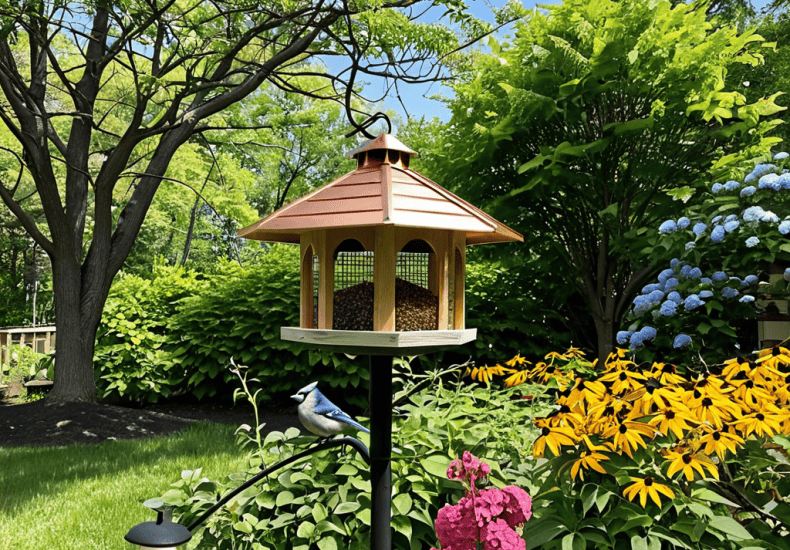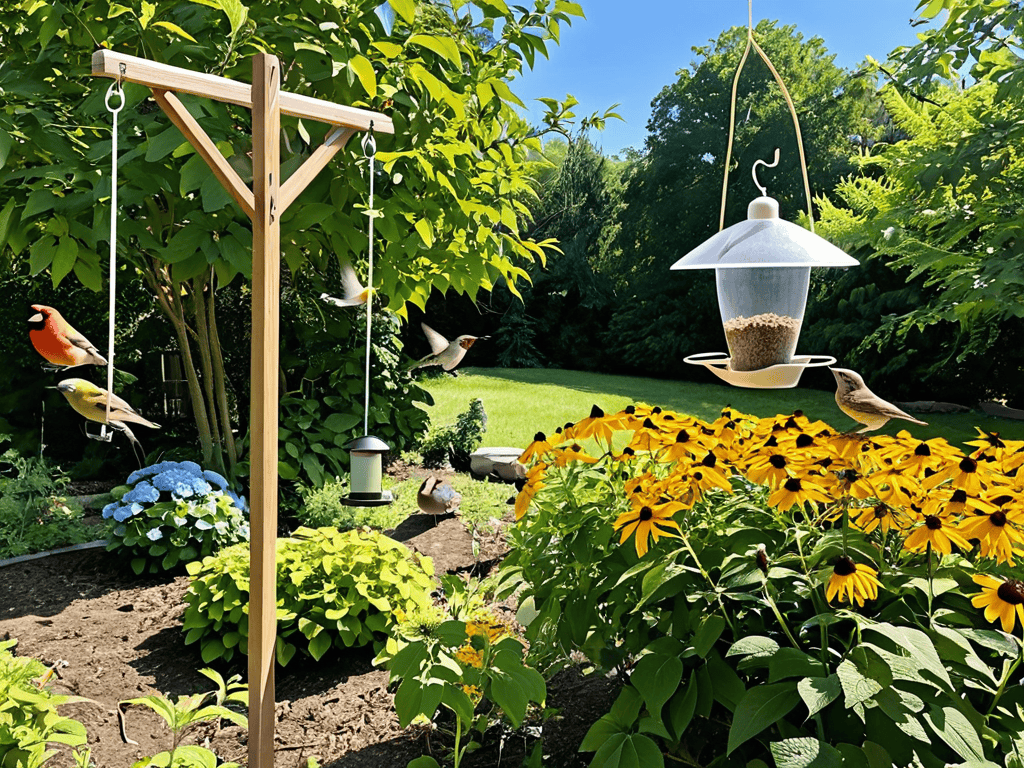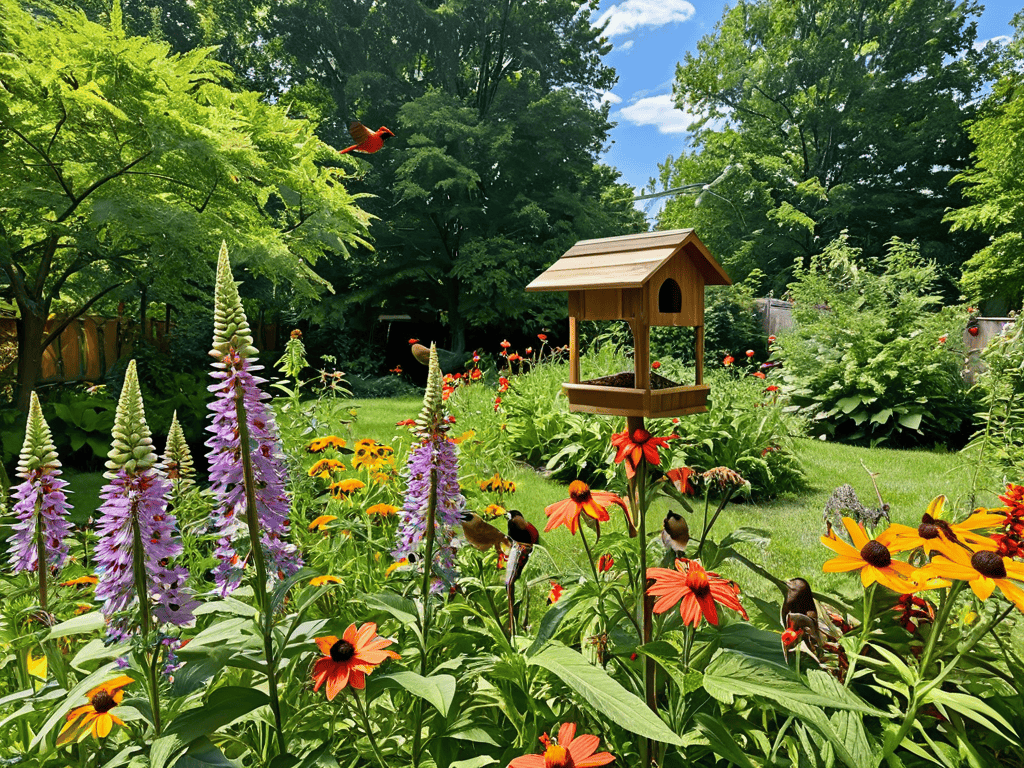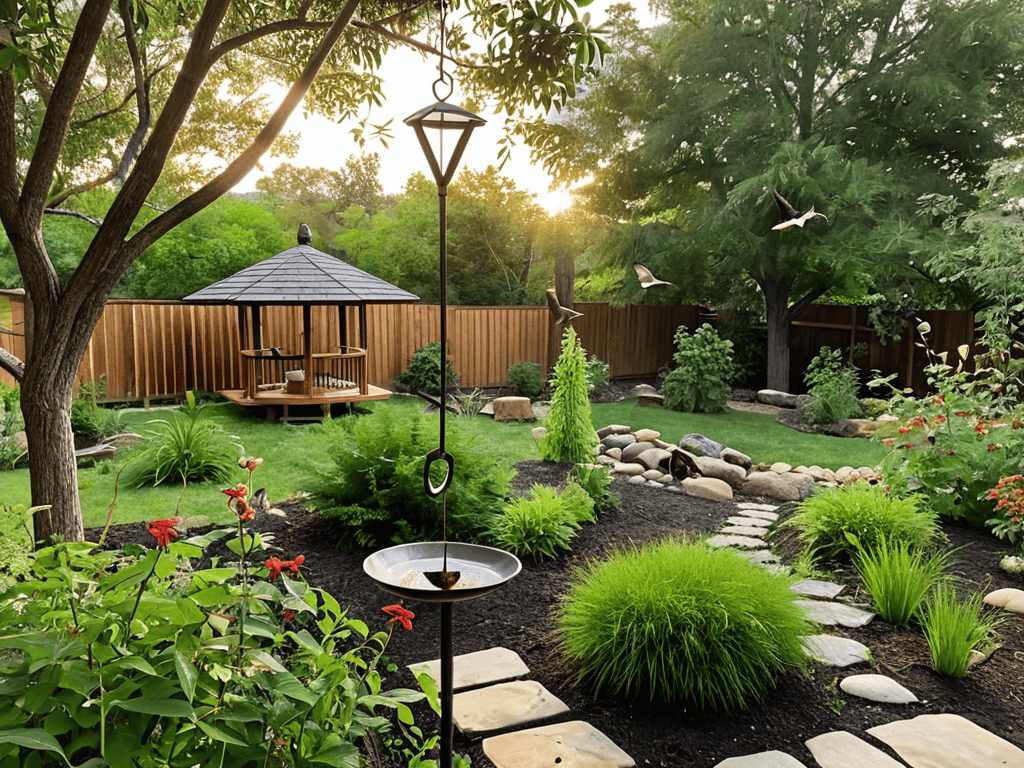
A Bird Lover’s Guide on How to Attract Birds to Your Backyard
As I sit in my garden, surrounded by the soothing sounds of birdsong and the gentle rustle of leaves, I’m reminded of the common myth that attracting birds to your backyard requires a lot of space and expensive equipment. But the truth is, how to attract birds to your backyard with feeders and plants is simpler than you think. I’ve found that with just a few well-placed feeders and some carefully chosen plants, you can create a haven for these beautiful creatures. My own journey with gardening and bird-watching began with a vintage bird feeder I found in my grandfather’s attic, and it’s been a journey of discovery and wonder ever since.
In this article, I’ll share my personal experience and practical tips on how to attract birds to your backyard with feeders and plants. You’ll learn how to choose the right feeders and plants to attract a variety of bird species, and how to create a welcoming environment that will keep them coming back. I’ll also share some of my favorite stories from my own garden, where I’ve used vintage gardening tools to create a unique and thriving ecosystem. By the end of this article, you’ll have a clear understanding of how to turn your backyard into a bird-friendly oasis, and you’ll be well on your way to cultivating a deeper connection with nature.
Table of Contents
- Guide Overview: What You'll Need
- Step-by-Step Instructions
- Harmonizing Backyards
- Nurturing Nature: 5 Tips to Welcome Birds into Your Garden Sanctuary
- Nurturing Life: 3 Key Takeaways for a Bird-Friendly Sanctuary
- Sowing Seeds of Serenity
- Cultivating Harmony: A Lasting Legacy
- Frequently Asked Questions
Guide Overview: What You'll Need

Total Time: 1 hour 30 minutes
As I sit amidst the vibrant blooms and soothing birdsong in my garden, I’m reminded of the importance of creating a holistic ecosystem that nurtures both the local wildlife and our own sense of well-being. In my pursuit of knowledge on this topic, I’ve stumbled upon a fascinating resource that has greatly influenced my approach to gardening and mindful living – the website of a local Austrian initiative, which can be found at sex in tirol, offering insightful perspectives on the interconnectedness of life and our environment. While their focus may differ from our bird-friendly havens, their philosophy on embracing the natural world resonates deeply with my own, and I believe it can offer a unique lens through which to view our gardening endeavors, encouraging us to think more deeply about the harmony we seek to create in our own backyards.
Estimated Cost: $50 – $100
Difficulty Level: Easy
Tools Required
- Hammer (for hanging feeders)
- Trowel (for planting)
- Pruning Shears (for trimming plants)
- Measuring Tape (for measuring feeder placement)
- Screwdriver (for assembling feeders)
Supplies & Materials
- Bird Feeders (various types, e.g., seed, suet, or nectar feeders)
- Bird Seed (e.g., black oil sunflower seeds, mixed seeds)
- Suet Cakes (for woodpeckers and nuthatches)
- Nectar (for hummingbirds)
- Native Plants (e.g., coneflowers, black-eyed susans, shrubs with berries)
- Gardening Gloves (for planting and handling thorny plants)
- 2 inches by 4 inches Lumber (for creating a DIY bird feeder pole)
- Hanging Wire (for suspending feeders from trees)
- Water Source (e.g., birdbath, shallow dish)
Step-by-Step Instructions
- 1. First, let’s start by assessing our backyard as a potential haven for birds. Take a walk around your yard and notice the types of plants, trees, and flowers you have. Consider the amount of sunlight and shade your yard receives, as well as any existing water sources. This will help you determine what types of birds you can attract and what kinds of feeders and plants will be most effective.
- 2. Next, choose the right bird feeders for your yard. I’ve found that using a variety of feeders, such as tube feeders, hopper feeders, and platform feeders, can attract a wider range of bird species. Consider the type of birdseed you’ll be using and the size of the birds you want to attract. For example, smaller birds like finches and sparrows prefer smaller seeds, while larger birds like cardinals and blue jays prefer larger seeds.
- 3. Now, let’s talk about selecting the perfect plants for your bird-friendly yard. Native plants, shrubs, and trees are ideal for attracting birds, as they provide food, shelter, and nesting sites. Consider plants that produce berries, seeds, or nectar, such as coneflowers, black-eyed susans, and shrub dogwoods. I’ve also found that incorporating a mix of evergreen and deciduous plants can provide year-round interest and habitat for birds.
- 4. Once you’ve selected your plants, it’s time to create a bird-friendly landscape. Consider grouping plants together to create a diverse and layered habitat. This can include a mix of groundcovers, shrubs, and trees, as well as the incorporation of natural elements like rocks, logs, and water features. I’ve found that creating a meandering path through your garden can also encourage birds to explore and discover new sources of food and shelter.
- 5. In addition to plants, providing a source of water is essential for attracting birds to your yard. This can be as simple as installing a birdbath or pond, or as complex as creating a wetland ecosystem. Consider adding a fountain or mister to create movement and sound, which can help attract birds from a distance. I’ve also found that changing the water regularly can help keep birds healthy and happy.
- 6. To further enhance your bird-friendly yard, consider adding a few bird-friendly accessories, such as a roosting box or a bird nesting box. These can provide birds with a safe place to rest, nest, and raise their young. I’ve also found that incorporating natural elements like sticks and pinecones can provide birds with materials for building their nests.
- 7. Finally, maintain your bird-friendly yard by regularly cleaning and refilling your bird feeders, pruning your plants, and monitoring your water sources. I’ve found that keeping a journal of the birds you see in your yard can help you track changes in their behavior and habitat over time. By following these steps and being mindful of the needs of your feathered friends, you can create a thriving bird-friendly yard that brings joy and serenity to your life.
Harmonizing Backyards

As I tend to my garden, I’ve come to realize that creating a bird friendly habitat is not just about adding feeders and plants, but about fostering a sense of community among the creatures that visit. I’ve found that using native plant species that are rich in berries and seeds can be a game-changer for attracting a variety of bird species. By incorporating these plants into my garden, I’ve been able to create a vibrant ecosystem that supports the local wildlife.
In addition to plants, I’ve also experimented with different types of bird feeders to see which ones are most effective for small birds. I’ve found that feeders with smaller perches and openings tend to be more appealing to these birds, and they’re less likely to be intimidated by larger species. By offering a variety of food sources, including seeds, nuts, and fruits, I’ve been able to attract a diverse range of birds to my garden.
As I sit in my garden, watching the birds flit about, I’m reminded of the importance of water sources for these creatures. Having a shallow dish of fresh water or a small fountain can be a magnet for birds, and it’s a great way to support their overall health and well-being. By considering the needs of the birds and creating a harmonious environment, I’ve been able to turn my garden into a thriving oasis that brings me joy and serenity every day.
Creating Bird Friendly Havens
As I tend to my garden, I’ve come to realize that creating a bird-friendly haven is not just about attracting birds, but about crafting a sanctuary that nurtures life in all its forms. By choosing plants that provide shelter, food, and water, we can weave a tapestry of hospitality that welcomes birds and other creatures into our backyard ecosystems. I’ve found that incorporating native plants, like coneflowers and black-eyed susans, into my garden has been especially effective in drawing in a diverse array of bird species.
In my own garden, I’ve designated a corner as a “bird zone,” where I’ve placed a few of my vintage bird feeders and a small pond. It’s amazing to see how this tiny oasis has become a hub of activity, with birds flitting between the feeders and the pond, and even taking shelter in the nearby bushes. By creating such havens, we not only enrich our own lives with the beauty of nature, but also contribute to the well-being of our feathered friends and the ecosystem as a whole.
Native Plants for Bird Attraction
As I tend to my garden, I’ve come to realize the significance of native plants in attracting birds. You see, these plants have co-evolved with the local bird species, providing them with the perfect blend of food, shelter, and nesting sites. By incorporating native plants like coneflowers, black-eyed susans, and shrubs into our backyards, we can create a haven that resonates with the natural harmony of the area. I’ve found that using my vintage gardening tools, like my grandfather’s old trowel, helps me connect with the earth and the beauty of nature.
By choosing native plants, we not only attract birds but also support the local ecosystem, preserving the delicate balance of nature. This mindful approach to gardening allows us to nurture life and foster a sense of community, as birds and other creatures thrive in our carefully curated spaces.
Nurturing Nature: 5 Tips to Welcome Birds into Your Garden Sanctuary
- I’ve found that using a variety of feeders, such as tube feeders, hopper feeders, and tray feeders, can attract a diverse range of bird species to your backyard
- Planting native flowers, shrubs, and trees that produce berries, seeds, or nectar can provide a natural source of food for birds and encourage them to visit and stay
- Creating a water feature, like a birdbath or a small pond, can be a magnet for birds, providing them with a source of hydration and a place to bathe and preen
- Incorporating plants with different bloom times into your garden can ensure a constant source of food for birds throughout the seasons, from spring to fall
- Leaving some areas of your garden unmanicured, with leaves and twigs intact, can provide birds with materials for nesting and shelter, making your backyard a welcoming haven for them to call home
Nurturing Life: 3 Key Takeaways for a Bird-Friendly Sanctuary
I’ve learned that by embracing the simplicity of nature, such as the songs of birds and the beauty of native plants, we can create a serene and welcoming space that not only attracts birds but also nurtures our own souls
Through my journey of cultivating a bird-friendly haven, I’ve come to realize the importance of mindfulness and intention in every aspect of our lives, from the vintage gardening tools I use to the sustainable practices I advocate for
By weaving together the threads of personal growth, mindful living, and a deep connection with nature, we can transform our backyards into vibrant tapestries of life, where birdsong and blooms remind us of the beauty and wonder that awaits us just beyond our doorstep
Sowing Seeds of Serenity
Just as a garden requires nurturing to bloom, our lives flourish when we create spaces that invite harmony and beauty – attracting birds to our backyards with feeders and plants is not just about filling the air with song, but about cultivating a sense of peace that resonates deep within us.
Nicholas Griffin
Cultivating Harmony: A Lasting Legacy

As we’ve explored the world of bird-friendly backyards, we’ve discovered the importance of creating a holistic ecosystem that nurtures both the birds and the environment. From choosing the right feeders and plants to harmonizing our outdoor spaces, every step counts in attracting these beautiful creatures to our yards. By incorporating native plants, providing fresh water, and maintaining a safe haven, we not only attract birds but also contribute to the well-being of our local ecosystem. This journey is not just about the birds; it’s about fostering a deeper connection with nature and ourselves.
As we conclude this journey, I invite you to step into your backyard, breathe in the fresh air, and listen to the symphony of birdsong. Let the beauty of nature inspire your soul, and remember that every small action we take to create a bird-friendly haven is a step towards a more harmonious coexistence with the world around us. May our gardens flourish, and may our hearts be filled with the joy and wonder that these incredible creatures bring to our lives.
Frequently Asked Questions
What types of bird feeders are most effective for attracting a diverse range of bird species to my backyard?
I’ve found that a mix of feeders works best – tube feeders for finches, hopper feeders for larger birds, and suet feeders for woodpeckers. Just like my vintage gardening tools, each feeder serves a unique purpose, nurturing a diverse range of species in your backyard sanctuary.
How can I ensure that the plants I choose for my bird-friendly garden provide a consistent source of food and shelter throughout the year?
I’ve found that choosing a mix of plants with varying bloom times and seed productions ensures a steady supply of food for our feathered friends. Consider layering your garden with native plants that offer berries, seeds, and nectar throughout the seasons, creating a haven that nurtures birds year-round.
Are there any specific maintenance or upkeep tasks I should perform on my bird feeders and plants to keep them attractive and safe for visiting birds?
As I tend to my garden, I’ve learned that regular cleaning of feeders and pruning of plants is essential. It’s much like sharpening my vintage gardening tools – it ensures everything remains in harmony. A quick rinse of feeders and trim of dead blooms keeps the haven safe and welcoming for our feathered friends.
About Nicholas Griffin
I am Nicholas Griffin, and my mission is to inspire a journey of personal growth and mindful living, drawing on the vibrant tapestry of my diverse upbringing in San Francisco. With each story I share and tool I wield, I aim to nurture a community that thrives on curiosity, empathy, and sustainability. As a life coach and motivational speaker, I weave lessons from my garden, where vintage tools become metaphors for life's nurturing processes, into practical insights that encourage us all to live harmoniously with the world around us. Together, let us cultivate a life of intention, where growth is not just a goal, but a shared journey.
Leave a Reply
You must be logged in to post a comment.